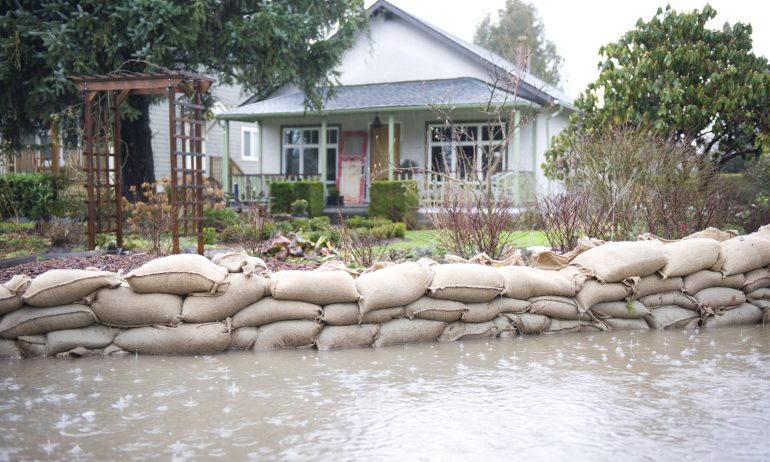How to File a Flood Insurance Claim

Many or all of the products featured here are from our partners who compensate us. This influences which products we write about and where and how the product appears on a page. However, this does not influence our evaluations. Our opinions are our own. Here is a list of our partners and here's how we make money.
Having flood insurance is a relief if your home has suffered water damage. But to get reimbursed, you’ll need to file your flood insurance claim promptly and provide the documentation your insurer requires.
The following advice is for those who have policies backed by the National Flood Insurance Program, the nation’s largest flood insurer. If you have private flood insurance, claim timelines and procedures may differ depending on the terms of your policy. Contact your agent or insurer for guidance.
Note: Homeowners insurance generally doesn’t cover flood damage. Here’s how to get help if you have no flood insurance.

How to file a flood insurance claim
Follow these tips for a smoother flood insurance claims process.
File as soon as possible
Don’t put off filing a claim. As soon as it’s safe to inspect your property, start your claim by reaching out to your agent or insurance company. (NFIP policies are usually administered by companies such as Allstate, Liberty Mutual and American Family.)
The sooner you file, the sooner you’ll get a payout, so it’s in your best interest to act quickly. But there’s also a deadline. For NFIP policies, you have 60 days after the flood to provide a proof of loss statement listing everything that was damaged or destroyed.
Ask whether you can get an advance payment to help with immediate recovery. The NFIP will subtract any such payment from your final claim settlement.
» MORE: What does flood insurance cover?
Document the damage
Ideally, you wouldn’t throw away damaged items until your claims adjuster sees them. However, you may do so if the items are hazardous to your health or you’re legally required to discard them. Just make sure to take photos or videos first. You’ll also want to keep material samples such as pieces of damaged carpet or flooring.
The Federal Emergency Management Agency, which runs the NFIP, recommends taking pictures of the serial numbers of large appliances such as refrigerators and laundry machines. Photograph the insides of drawers and cabinets if there’s damage there, too.
Note that an NFIP policy won’t cover mold damage unless official closures or lingering floodwaters keep you from entering your home. That’s why it’s important to start cleaning up as soon as possible after a flood.
As you go through the process, make a list of everything damaged or destroyed. This will help you write your proof of loss statement.
What happens next
Once you’ve filed your claim, an adjuster will inspect your property, in person or remotely. The adjuster will note damage to your belongings and the structure of your home and answer questions about the claims process.
Don’t sign contracts with remediation or repair companies until you’ve talked with your adjuster.
If the home is your primary residence, your policy will typically pay enough for you to restore the structure to its previous condition, using similar materials. For damaged belongings, you’ll receive their actual cash value. Say the flood destroyed a dining room set that you bought five years ago. Your payout for that item would reflect five years’ worth of depreciation and likely wouldn’t be enough for you to buy a new replacement.
For homes that have suffered significant or repeated damage, NFIP policies offer up to $30,000 of increased cost of compliance coverage. This coverage can pay to help you meet local building requirements for preventing flood damage.
If your community’s floodplain administrator says you’re eligible for this coverage, you’ll have to file a separate claim with your agent or insurance company.
How to appeal a flood insurance claim
If the NFIP denies your flood claim, you have the right to appeal the decision. FEMA recommends that policyholders discuss disputes with their insurers first.
During the appeal process, keep a detailed record of every call you make to your insurer. Note the name and title of everyone you speak with, what you talk about and the dates and times of each conversation.
If you can’t resolve the dispute with your insurer, you may file an appeal with FEMA. You must do so within 60 days of your insurer’s written denial.
Your appeal must include:
Your policy number.
The names of the policyholder(s).
The address of the flooded property.
Your contact information.
A copy of the insurance company’s denial notice.
Details about your concern.
Documentation to support your appeal.
Email the appeal to [email protected] or mail it to: FEMA; 400 C Street SW, 6th Floor; Washington, D.C., 20472-3010.
FEMA notes that it starts processing emailed appeals more quickly than those submitted by mail.
FEMA will acknowledge your appeal in writing and request the claim file from your insurer. It might also ask for more information or request that your property be inspected again. Requests for more information will likely have a 14-day deadline.
If it agrees with your appeal, FEMA will inform you and your insurer and recommend actions for the insurer to take. If it disagrees, FEMA will explain why.
The appeal may raise new questions or reveal documentation you hadn't provided to your insurer before it denied the claim. If so, FEMA might tell you to submit this information directly to the insurance company to get extra payment.
If you’re still unhappy with your claim resolution after the appeal process, your only other option is to file a lawsuit.

Why your flood claim could be denied
Your insurer might have a legitimate reason for denying your claim. If that’s the case, it's probably not worth the time it takes to appeal. Below are a few examples.
You’re inside the waiting period. NFIP flood insurance comes with a 30-day waiting period before it takes effect. If you have flood damage before that time is up, insurance won’t help you.
You missed the proof of loss filing deadline. You have 60 days from the time of damage to file a flood insurance claim. If you wait any longer, even if you’re displaced, the NFIP could deny your claim. Sometimes the agency will waive this deadline after a severe disaster, but not always.
There was earth movement. Flood insurance won’t pay for damage from landslides, earthquakes or other earth movement, even if a flood caused them. If your insurer denies your claim because of this exclusion, consider hiring a licensed professional engineer to determine the exact cause of damage. Make sure the engineer has experience with flood damage. They may determine the damage is from hydrostatic pressure, which flood insurance typically covers, rather than earth movement. If that’s the case, include the findings in your appeal.
You had pre-existing damage. If water damage is confined to your home, was preventable — like a slow water leak — or occurred before you bought insurance, an NFIP flood insurance policy generally won’t cover it.
You have basement damage. NFIP policies provide some limited coverage for basement areas, but it doesn’t include basement improvements or most personal belongings.


